
The morpho butterflies comprise many species of Neotropical butterfly under the genus Morpho. This genus includes more than 29 accepted species and 147 accepted subspecies, found mostly in South America, Mexico, and Central America. Morpho wingspans range from 7.5 cm (3.0 in) for M. rhodopteron to 20 cm (7.9 in) for M. hecuba, the imposing sunset morpho. The name morpho, meaning "changed" or "modified", is also an epithet. Blue morphos are severely threatened by the deforestation of tropical forests and habitat fragmentation. Humans provide a direct threat to this spectacular creature because their beauty attracts artists and collectors from all over the globe who wish to capture and display them. Aside from humans, birds like the jacamar and flycatcher are the adult butterfly’s natural predators.
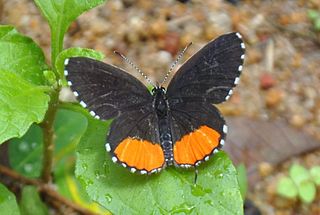
Talicada nyseus, the red Pierrot, is a small but striking butterfly found in the Indian subcontinent and South-East Asia belonging to the lycaenids, or blues family. The red Pierrots, often found perching on its larva host plant, Kalanchoe, are usually noticed due to their striking patterns and colors.

Papilio helenus, the red Helen, is a large swallowtail butterfly found in forests of southern India and parts of southeast Asia.

Elymnias hypermnestra, the common palmfly, is a species of satyrine butterfly found in South and Southeast Asia.
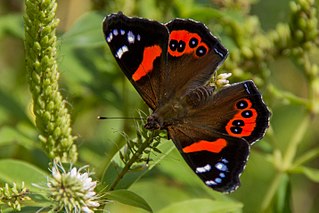
The New Zealand red admiral is a butterfly endemic to New Zealand. Its Māori name is kahukura, which means "red cloak". The red admiral is a member of the family Nymphalidae, the subfamily Nymphalinae and the tribe Nymphalini. There are two subspecies: V. g. gonerilla, which occurs on the mainland of New Zealand, and V. g. ida, which occurs on the Chatham Islands.

Belenois aurota, the pioneer or pioneer white or caper white, is a small to medium-sized butterfly of the family Pieridae, that is, the yellows and whites, which is found in South Asia and Africa. In Africa, it is also known as the brown-veined white, and is well known during summer and autumn when large numbers migrate north-east over the interior.

Papilio nephelus is a species of swallowtail butterfly belonging to the family Papilionidae. Subspecies include P. n. chaon, the yellow Helen, and P. n. sunatus, the black and white Helen.

Zemeros flegyas, the Punchinello, is a small butterfly found in South Asia and Southeast Asia that belongs to the family Riodinidae.

Euploea mulciber, the striped blue crow, is a butterfly found in India and Southeast Asia that belongs to the crows and tigers, that is, the danaid group of the brush-footed butterflies family.

Graphium codrus is a butterfly of the family Papilionidae, that is found in the Philippines, Celebes and Solomon Islands.

Morpho achilles, the Achilles morpho, blue-banded morpho, or banded blue morpho, is a Neotropical butterfly.

Morpho deidamia, the Deidamia morpho, is a Neotropical butterfly. It is found in Panama, Nicaragua, Costa Rica, Suriname, Bolivia, Venezuela, Colombia, Peru, Ecuador, and Brazil. It is a species group, which may be, or may not be several species. Many subspecies have been described.

Morpho aega, the Aega morpho, is a Neotropical butterfly found in Paraguay, Argentina and Brazil.
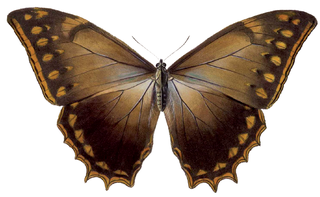
Morpho theseus, the Theseus morpho, is a Neotropical butterfly. It is found in Panama, Costa Rica, Mexico, Colombia, Peru, Ecuador, Venezuela, Honduras and Guatemala.
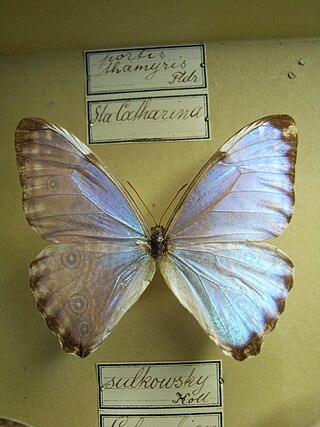
Morpho portis is a Neotropical butterfly. It is found in Brazil, Uruguay, Venezuela, Colombia, Peru, and Paraguay. Several subspecies and many forms have been described. The larvae feed on Gramineae.

Morpho rhetenor, the Rhetenor blue morpho, is a Neotropical butterfly of the family Nymphalidae. It is found in Suriname, French Guiana, Brazil, Peru, Ecuador, Colombia, and Venezuela.
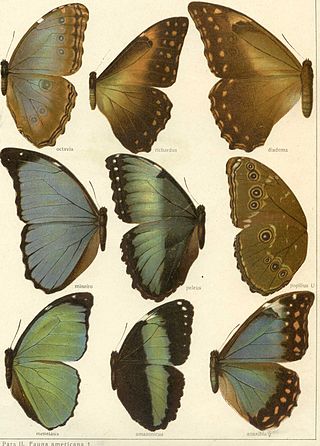
Morpho richardus, or Richard's morpho, is a Neotropical butterfly found only in Minas Gerais, Brazil.
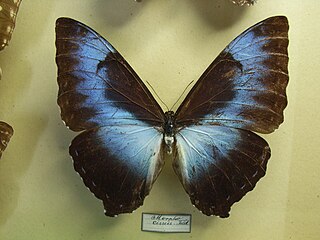
Morpho cisseis, the Cisseis morpho, is a large Neotropical butterfly found in the southern and western Amazon in Bolivia, Colombia, Peru, Ecuador, and Brazil. It includes several subspecies, but has itself sometimes been treated as a subspecies of the sunset morpho. Both are highly valued by collectors.
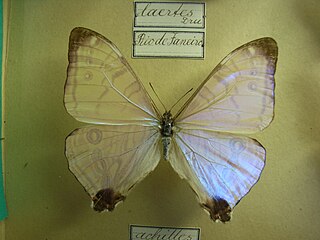
Morpho laertes, the White morpho or Epistrophus white morpho, is a Neotropical butterfly found in Brazil, Uruguay, Paraguay, and Argentina. The white morpho is native to the Atlantic Forest, where they are distributed throughout a landscape of multiple species.

Morpho telemachus is a Neotropical butterfly.




















